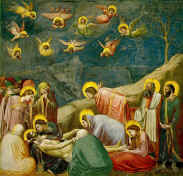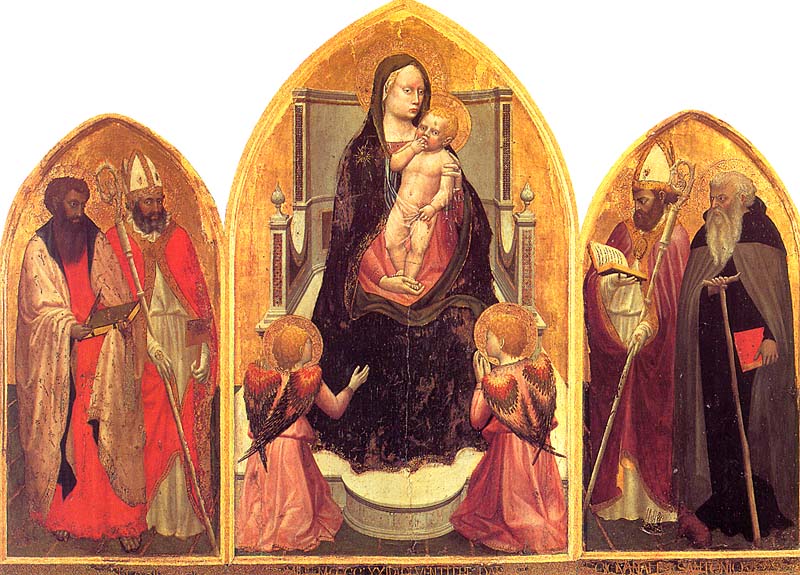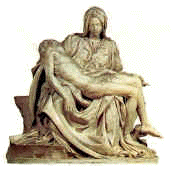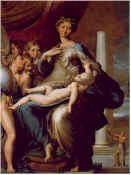|



During the fourteenth century (1300's), art began a steady climb back to the levels of
proportional accuracy
and naturalism seen two
thousand years earlier in Greece. In fact, Renaissance art in many ways mirrors the
evolution of art in ancient Greece. Painting in the Renaissance began with a somewhat
simple and austere style in the 1300's,
similar to the Greek Archaic style.
|
Duccio
and Giotto
serve as examples of the transition from the artistic style of the Middle Ages to the
Renaissance. Duccio, who lived in Sienna, continued to work in the formalized style of the
Middle Ages. Giotto, from Florence, created a revolution in painting by depicting
characters that displayed vivid emotion.
Florence
became the center of the Italian Renaissance. Petrarch, the
poet, and
Dante
,
author of the
Inferno
and the
Divine
Comedy
,
were Florentine. Artists
Masaccio
,
Michelangelo, Donatello
and Raphael
were also from Florence. Advances in architecture and technology also flourished during
the Renaissance. The architect
Filipo
Brunelleschi
was among the first to incorporate
scientific perspective
into his work. Brunelleschi
was a significant contributor to Florentine architecture. One of his works is the dome of
the great cathedral,
Santa Maria
Della Fiori
.
Titian,
Tintoretto
and Veronese, from Venice, were other Renaissance artists considered equal in stature to
the Florentines. Perhaps the most prolific Renaissance man was the artist, inventor and
visionary,
Leonardo
Da Vinci
.
During the Middle Ages, nearly all art was produced for religious reasons. Art was
frequently a method of teaching or reminding an illiterate
population about the tenets of their faith.
During the Renaissance, the wealthy middle class began to commission artists to produce a secular art that included numerous references to
ancient pagan mythologies. Michelangelo
painted nude figures and pagan prophets on the ceilings and walls of the Pope's private Sistine Chapel.
Botticelli
painted images that would have been seen as sacrilegious during the Middle Ages on the
walls of Renaissance palaces.
|

Giotto's "Mourning Christ"

Masaccio's
San Giovenale Triptych

Michelangelo's Sculpture "The Pieta"
|
As the 1400's progressed, art gradually became more complex and expressive. Artists
refined their technical skills and pictorial representation, similar to the Greek
Classical period. Renaissance artists acknowledged their debt to the ancient world.
Michelangelo is quoted as saying:
"If we see far it is because we stand on the
shoulders of giants."
In the middle of the 1400’s, Guttenberg
invented the printing press, making printed materials available to the general public for
the first time.
The use of Greek and Roman mythological figures by artists produced a backlash during
the late 1400's and early 1500's. Counter-reformation priests, such as the Dominican
Savanorola, preached against the "new paganism." In Catholic Italy, artists were
compelled to seek approval of the Inquisition
to guarantee religious conformity when performing public commissions.
|
Towards the middle of the 16th century, art entered a period characterized by
exaggeration and excess similar to Greco-Roman Hellenism. During the Renaissance, artists
generally sought to bring a classical balance to their work, but around the middle of the
16th century, a style called the "grand manner", by the Italian writer
Vasari,
became popular. It is known to modern art historians as
Mannerism
.
This style,
perhaps inspired by the later work of Michelangelo, featured distorted, elongated forms,
false perspective and elements that seemed to parody
the classical style. Mannerists in Italy included
Parmagianino
and Bronzino.
Mannerists from other countries included El Greco in Spain and Peter Brueghel in
the Netherlands.
|

Parmagianino's
"Virgin with the Long Neck"
|
Some Art historians have attributed the Mannerist movement to the inability of artists
in the last part of the century to compete with the titanic personalities of Michelangelo,
Leonardo Da Vinci and Raphael. Mannerism was the antithesis
of classicism and had much in common with the Hellenistic style of post-classical Greece
and Rome.

Additional Resources

[ Italian Renaissance Things to Know ] [ Italian Renaissance Questions ] [ Italian Renaissancec Critical Thinking ]

|
![]()